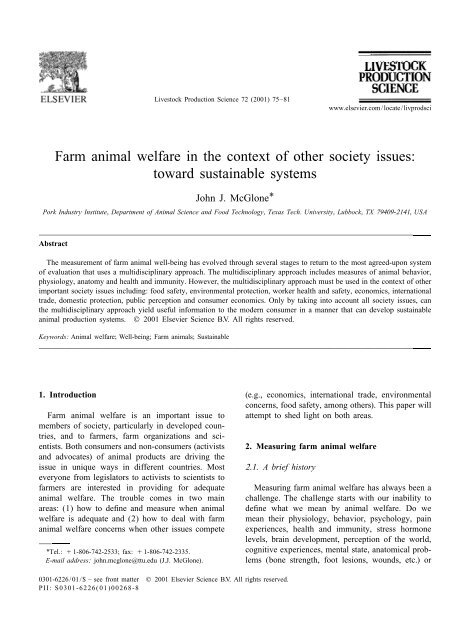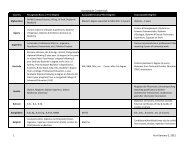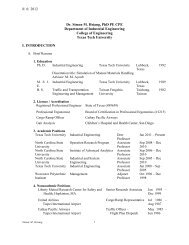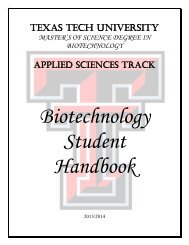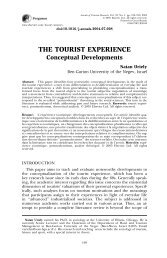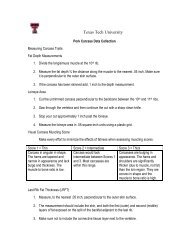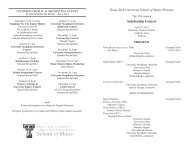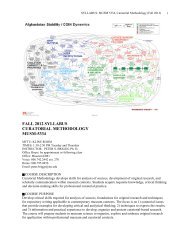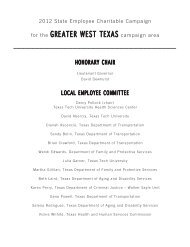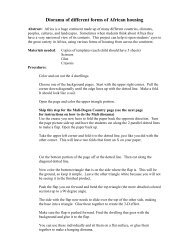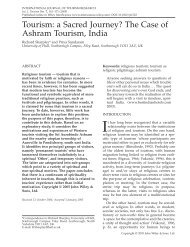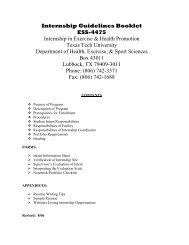Farm animal welfare in the context of other society issues: toward ...
Farm animal welfare in the context of other society issues: toward ...
Farm animal welfare in the context of other society issues: toward ...
Create successful ePaper yourself
Turn your PDF publications into a flip-book with our unique Google optimized e-Paper software.
Livestock Production Science 72 (2001) 75–81<br />
www.elsevier.com/locate/livprodsci<br />
<strong>Farm</strong> <strong>animal</strong> <strong>welfare</strong> <strong>in</strong> <strong>the</strong> <strong>context</strong> <strong>of</strong> o<strong>the</strong>r <strong>society</strong> <strong>issues</strong>:<br />
<strong>toward</strong> susta<strong>in</strong>able systems<br />
John J. McGlone*<br />
Pork Industry Institute, Department <strong>of</strong> Animal Science and Food Technology, Texas Tech. University, Lubbock, TX 79409-2141, USA<br />
Abstract<br />
The measurement <strong>of</strong> farm <strong>animal</strong> well-be<strong>in</strong>g has evolved through several stages to return to <strong>the</strong> most agreed-upon system<br />
<strong>of</strong> evaluation that uses a multidiscipl<strong>in</strong>ary approach. The multidiscipl<strong>in</strong>ary approach <strong>in</strong>cludes measures <strong>of</strong> <strong>animal</strong> behavior,<br />
physiology, anatomy and health and immunity. However, <strong>the</strong> multidiscipl<strong>in</strong>ary approach must be used <strong>in</strong> <strong>the</strong> <strong>context</strong> <strong>of</strong> o<strong>the</strong>r<br />
important <strong>society</strong> <strong>issues</strong> <strong>in</strong>clud<strong>in</strong>g: food safety, environmental protection, worker health and safety, economics, <strong>in</strong>ternational<br />
trade, domestic protection, public perception and consumer economics. Only by tak<strong>in</strong>g <strong>in</strong>to account all <strong>society</strong> <strong>issues</strong>, can<br />
<strong>the</strong> multidiscipl<strong>in</strong>ary approach yield useful <strong>in</strong>formation to <strong>the</strong> modern consumer <strong>in</strong> a manner that can develop susta<strong>in</strong>able<br />
<strong>animal</strong> production systems. © 2001 Elsevier Science B.V. All rights reserved.<br />
Keywords: Animal <strong>welfare</strong>; Well-be<strong>in</strong>g; <strong>Farm</strong> <strong>animal</strong>s; Susta<strong>in</strong>able<br />
1. Introduction (e.g., economics, <strong>in</strong>ternational trade, environmental<br />
concerns, food safety, among o<strong>the</strong>rs). This paper will<br />
<strong>Farm</strong> <strong>animal</strong> <strong>welfare</strong> is an important issue to attempt to shed light on both areas.<br />
members <strong>of</strong> <strong>society</strong>, particularly <strong>in</strong> developed countries,<br />
and to farmers, farm organizations and scientists.<br />
Both consumers and non-consumers (activists 2. Measur<strong>in</strong>g farm <strong>animal</strong> <strong>welfare</strong><br />
and advocates) <strong>of</strong> <strong>animal</strong> products are driv<strong>in</strong>g <strong>the</strong><br />
issue <strong>in</strong> unique ways <strong>in</strong> different countries. Most 2.1. A brief history<br />
everyone from legislators to activists to scientists to<br />
farmers are <strong>in</strong>terested <strong>in</strong> provid<strong>in</strong>g for adequate Measur<strong>in</strong>g farm <strong>animal</strong> <strong>welfare</strong> has always been a<br />
<strong>animal</strong> <strong>welfare</strong>. The trouble comes <strong>in</strong> two ma<strong>in</strong> challenge. The challenge starts with our <strong>in</strong>ability to<br />
areas: (1) how to def<strong>in</strong>e and measure when <strong>animal</strong> def<strong>in</strong>e what we mean by <strong>animal</strong> <strong>welfare</strong>. Do we<br />
<strong>welfare</strong> is adequate and (2) how to deal with farm mean <strong>the</strong>ir physiology, behavior, psychology, pa<strong>in</strong><br />
<strong>animal</strong> <strong>welfare</strong> concerns when o<strong>the</strong>r <strong>issues</strong> compete experiences, health and immunity, stress hormone<br />
levels, bra<strong>in</strong> development, perception <strong>of</strong> <strong>the</strong> world,<br />
*Tel.: 1 1-806-742-2533; fax: 1 1-806-742-2335.<br />
cognitive experiences, mental state, anatomical prob-<br />
E-mail address: john.mcglone@ttu.edu (J.J. McGlone). lems (bone strength, foot lesions, wounds, etc.) or<br />
0301-6226/01/$ – see front matter © 2001 Elsevier Science B.V. All rights reserved.<br />
PII: S0301-6226(01)00268-8
76 J.J. McGlone / Livestock Production Science 72 (2001) 75 –81<br />
some o<strong>the</strong>r yet-to-be-def<strong>in</strong>ed term? Authors argue for several decades. We started, more-or-less with<br />
about what we mean by <strong>animal</strong> <strong>welfare</strong>, but <strong>in</strong> <strong>the</strong> well-known people (Sa<strong>in</strong>sbury, 1972; Hughes, 1973;<br />
end, it is <strong>the</strong> public’s perception that will drive <strong>the</strong> Wood-Gush, 1973; Dawk<strong>in</strong>s, 1976; Fraser, 1980;<br />
issue.<br />
Curtis, 1985; Ewbank, 1985 and o<strong>the</strong>rs) <strong>of</strong>fer<strong>in</strong>g a<br />
In <strong>the</strong> USA, we have developed <strong>animal</strong> <strong>welfare</strong> multidiscipl<strong>in</strong>ary approach to assessment <strong>of</strong> farm<br />
legislation and regulation on a different track than <strong>in</strong> <strong>animal</strong> <strong>welfare</strong>. As time went on, some people, most<br />
Europe. With<strong>in</strong> Europe, countries vary <strong>in</strong> <strong>animal</strong> notably Duncan, suggested that <strong>animal</strong> <strong>welfare</strong> had<br />
<strong>welfare</strong> laws and regulations as well. In <strong>the</strong> USA, <strong>the</strong> to do with how <strong>animal</strong>s feel and by default, not with<br />
US Congress was not stopped by not be<strong>in</strong>g able to <strong>the</strong>ir physiology or o<strong>the</strong>r measures (Duncan, 1993).<br />
def<strong>in</strong>e a term on this issue. For laboratory non- This view is consistent with <strong>the</strong> views <strong>of</strong> <strong>the</strong> public<br />
human primates, <strong>the</strong> 1985 revision <strong>of</strong> <strong>the</strong> Animal who have little understand<strong>in</strong>g <strong>of</strong> physiology or o<strong>the</strong>r<br />
Welfare Act required that <strong>the</strong>se more-developed measures. At <strong>the</strong> time, this view was opposed by<br />
<strong>animal</strong>s have <strong>the</strong>ir ‘psychological needs’ met, even only a few authors some <strong>of</strong> which argued that<br />
though <strong>the</strong>y could not at <strong>the</strong> time, nor can we now, physiological measures were useful <strong>in</strong> <strong>the</strong> assessment<br />
precisely def<strong>in</strong>e what is meant by psychological <strong>of</strong> <strong>animal</strong> <strong>welfare</strong> (Moberg, 1987; Barnett, 1987) and<br />
needs. So we can see that lack<strong>in</strong>g <strong>the</strong> ability to a m<strong>in</strong>ority that argued that physiological measures<br />
precisely def<strong>in</strong>e a term does not preclude us from were preferred to behavioral measures <strong>in</strong> that <strong>the</strong>y<br />
us<strong>in</strong>g <strong>the</strong> term <strong>in</strong> governmental actions.<br />
were more objective and less prone to <strong>in</strong>dicate m<strong>in</strong>or<br />
<strong>Farm</strong> <strong>animal</strong> <strong>welfare</strong> <strong>in</strong> <strong>the</strong> USA became an issue homeostatic adjustments (McGlone, 1993).<br />
around 1906 when Upton S<strong>in</strong>clair published ‘‘The<br />
Jungle’’. After a few decades <strong>of</strong> debate, <strong>the</strong> Humane 2.2. <strong>Farm</strong> <strong>animal</strong> <strong>welfare</strong> and o<strong>the</strong>r <strong>society</strong> <strong>issues</strong>:<br />
Slaughter Act became law. Interest<strong>in</strong>gly, <strong>the</strong> issue multidiscipl<strong>in</strong>ary approaches<br />
was more related to food safety than to <strong>animal</strong><br />
<strong>welfare</strong>. Food sanitation was <strong>the</strong> first problem ad- All through <strong>the</strong> history <strong>of</strong> measur<strong>in</strong>g <strong>welfare</strong>,<br />
dressed, <strong>the</strong>n humane slaughter was tackled. Thus, <strong>in</strong> authors have argued for a multidiscipl<strong>in</strong>ary approach<br />
<strong>the</strong> early 1900s <strong>the</strong> USA l<strong>in</strong>ked food safety and to <strong>the</strong> measurement <strong>of</strong> <strong>animal</strong> <strong>welfare</strong> (Gonyou,<br />
<strong>animal</strong> <strong>welfare</strong> as <strong>issues</strong> aris<strong>in</strong>g from <strong>the</strong> same 1986; Broom, 1991) and this approach is <strong>the</strong> safest<br />
situation.<br />
and most reliable approach to <strong>the</strong> assessment <strong>of</strong><br />
In <strong>the</strong> 1960s <strong>animal</strong> <strong>welfare</strong> on farms became an <strong>animal</strong> <strong>welfare</strong>. By us<strong>in</strong>g a multidiscipl<strong>in</strong>ary apissue<br />
<strong>in</strong> <strong>the</strong> UK. The issue ga<strong>the</strong>red steam <strong>in</strong> Europe proach, if a reader wishes to put more weight on one<br />
from <strong>the</strong> 1960s to <strong>the</strong> present day. In <strong>the</strong> USA, <strong>the</strong> or more measures, <strong>the</strong>y can do so (Fig. 1). In a<br />
issue <strong>of</strong> farm <strong>animal</strong> <strong>welfare</strong> has been a part <strong>of</strong> realistic multidiscipl<strong>in</strong>ary assessment <strong>of</strong> <strong>animal</strong> welscientific<br />
discussions s<strong>in</strong>ce <strong>the</strong> late 1970s and a part fare, <strong>the</strong> follow<strong>in</strong>g measures should be <strong>in</strong>cluded:<br />
<strong>of</strong> Congressional debate s<strong>in</strong>ce <strong>the</strong> late 1980s. All <strong>the</strong><br />
discussion <strong>in</strong> both Europe and North America have • Level <strong>of</strong> productivity<br />
not been hampered by our lack <strong>of</strong> ability to def<strong>in</strong>e<br />
<strong>the</strong> key terms.<br />
• Direct <strong>animal</strong> productivity<br />
A conference was held with about 100 concerned • Human labor requirement<br />
people from several areas at <strong>the</strong> Wye Plantation <strong>in</strong> • Cost <strong>of</strong> production<br />
Maryland (USA) to def<strong>in</strong>e <strong>animal</strong> <strong>welfare</strong> (<strong>the</strong> • Behavior<br />
proceed<strong>in</strong>gs were published <strong>in</strong> 1993; see McGlone,<br />
1993). The plethora <strong>of</strong> def<strong>in</strong>itions and perspectives • Ma<strong>in</strong>tenance behaviors (stand<strong>in</strong>g, walk<strong>in</strong>g,<br />
was too much to develop a clear consensus on how<br />
ly<strong>in</strong>g, feed<strong>in</strong>g, dr<strong>in</strong>k<strong>in</strong>g)<br />
to def<strong>in</strong>e <strong>animal</strong> <strong>welfare</strong>. Although <strong>the</strong> result <strong>of</strong> <strong>the</strong> • Abnormal behaviors, <strong>in</strong>clud<strong>in</strong>g stereotyped<br />
conference was less-than-desired, <strong>the</strong> outcome re-<br />
behaviors<br />
ma<strong>in</strong>s today that we do not have to have a uniform • O<strong>the</strong>r appropriate behaviors such as reagreed-upon<br />
def<strong>in</strong>ition <strong>of</strong> <strong>welfare</strong> to be able to production, maternal–neonatal <strong>in</strong>teractions<br />
measure and study <strong>animal</strong> <strong>welfare</strong>.<br />
or o<strong>the</strong>r site or age-specific behaviors<br />
Among scientists, def<strong>in</strong>itions have been <strong>of</strong>fered • Physiology
J.J. McGlone / Livestock Production Science 72 (2001) 75 –81 77<br />
Fig. 1. The <strong>animal</strong> <strong>welfare</strong> matrix. Animals would be expected to have good <strong>welfare</strong> if <strong>the</strong>y receive a check <strong>in</strong> each box. If problems were<br />
identified uniformly over anatomy, physiology, behavior and productivity, most people would agree that <strong>the</strong> production method would be<br />
problematic. However, should <strong>the</strong> farm not qualify for an assurance that <strong>the</strong> <strong>welfare</strong> is adequate if <strong>the</strong>re is a problem <strong>in</strong> just one cell<br />
(represented by <strong>the</strong> *)?.<br />
• Endocr<strong>in</strong>e measures <strong>of</strong> stress (glucocor- • Community <strong>in</strong>teractions <strong>of</strong> <strong>the</strong> farm (related to<br />
ticoids and catecholam<strong>in</strong>es)<br />
pollution and o<strong>the</strong>r factors)<br />
• Blood pressure, heart rate, respiratory rate • Drug residues and <strong>animal</strong>-derived feedstuffs<br />
• Food safety (microbes and genetically-modified<br />
• Health and immunity<br />
feedstuffs)<br />
• International trade and protection <strong>of</strong> local food<br />
• Overall <strong>in</strong>cidence <strong>of</strong> disease<br />
production<br />
• Level <strong>of</strong> immune protection (many measures;<br />
see McGlone et al., 1994; Morrow-Tesch et The concept that ties toge<strong>the</strong>r <strong>the</strong> most <strong>issues</strong> is<br />
al., 1994)<br />
<strong>the</strong> concept <strong>of</strong> susta<strong>in</strong>able agricultural systems. If our<br />
• Anatomy<br />
systems <strong>of</strong> production are <strong>in</strong> harmony with <strong>the</strong><br />
environment, <strong>the</strong> <strong>animal</strong>s, <strong>the</strong> workers and <strong>the</strong><br />
• Bone strength and rate <strong>of</strong> <strong>in</strong>jury<br />
community and if <strong>the</strong>y are efficient and economically<br />
• Wound<strong>in</strong>g, especially <strong>of</strong> sk<strong>in</strong> (e.g., bites or competitive <strong>the</strong>n <strong>the</strong> system may be said to be<br />
abrasions)<br />
susta<strong>in</strong>able. Atta<strong>in</strong>ment <strong>of</strong> susta<strong>in</strong>ability is a tall<br />
order <strong>in</strong> today’s world. It may mean that some<br />
In addition to <strong>the</strong> above measures taken on <strong>the</strong> <strong>animal</strong> products can not be produced <strong>in</strong> some<br />
<strong>animal</strong>s, we must, <strong>in</strong> today’s <strong>society</strong>, take <strong>in</strong>to locations at <strong>the</strong> present level (e.g., livestock-dense<br />
consideration o<strong>the</strong>r <strong>society</strong> <strong>issues</strong>. Issues <strong>of</strong> impor- regions <strong>in</strong> wet climates near large populations <strong>of</strong><br />
tance to <strong>society</strong> today, that impact which production people).<br />
systems we use, <strong>in</strong>clude:<br />
The call for multidiscipl<strong>in</strong>ary evaluations both<br />
with<strong>in</strong> <strong>the</strong> field <strong>of</strong> farm <strong>animal</strong> <strong>welfare</strong> and especial-<br />
• Environmental impact, particularly <strong>of</strong> <strong>the</strong> soil, ly across systems <strong>of</strong> <strong>animal</strong> production is now<br />
water and air<br />
recognized <strong>in</strong> <strong>the</strong> USA and <strong>in</strong> Europe. The USDA<br />
• Worker health and safety<br />
has new fund<strong>in</strong>g opportunities dedicated to multidis-<br />
• <strong>Farm</strong>er economics<br />
cipl<strong>in</strong>ary large-scale studies <strong>of</strong> <strong>animal</strong> systems with<br />
• Consumer economics (cost to purchase such several areas <strong>of</strong> focus (www.reeusda.gov). In Europe,<br />
products)<br />
<strong>society</strong> <strong>issues</strong> have been a topic <strong>of</strong> discussion <strong>in</strong><br />
• Public perceptions (<strong>in</strong>clud<strong>in</strong>g production systems recent years with a focus on whole-system’s muland<br />
feed <strong>in</strong>gredients such as <strong>animal</strong> products or tidiscipl<strong>in</strong>ary evaluations (Sorensen, 1997).<br />
genetically modified feeds)<br />
On top <strong>of</strong> <strong>the</strong> consumer demands, historically, has
78 J.J. McGlone / Livestock Production Science 72 (2001) 75 –81<br />
been <strong>the</strong> cost <strong>of</strong> <strong>animal</strong> products. Today, at least <strong>in</strong> scheme for <strong>animal</strong> <strong>welfare</strong> assurance is <strong>the</strong> RSPCA’s<br />
developed countries, consumers demand a food that Freedom Food concept. In this scheme, one motto<br />
is first safe and second protects <strong>the</strong> environment. that has been used is ‘‘<strong>animal</strong> <strong>welfare</strong> at no extra<br />
Consumers can not confirm that <strong>the</strong> food <strong>the</strong>y eat has cost’’. This is a dangerous precedent because if <strong>the</strong><br />
any sort <strong>of</strong> environmental protection <strong>in</strong> most cases, farmers are asked to produce food at a higher cost<br />
but <strong>the</strong>y can sense fairly quickly if certa<strong>in</strong> food (abandon<strong>in</strong>g battery cages for hens, for example),<br />
safety safeguards have broken down (e.g., food <strong>the</strong>n <strong>the</strong> participat<strong>in</strong>g farmers are at an economic<br />
microbes). The only way to assure environmental or disadvantage. This can not go on for very long.<br />
<strong>animal</strong> <strong>welfare</strong> protection is through national legisla- While some production systems that might be<br />
tion or assurance schemes developed by a third party compatible with public perceptions about good ani-<br />
(o<strong>the</strong>r than <strong>the</strong> farmer or <strong>the</strong> consumer). The chal- mal <strong>welfare</strong> might not cost <strong>the</strong> consumer more, <strong>the</strong><br />
lenge for <strong>animal</strong> agriculture is to provide public general idea that <strong>animal</strong> products with greater <strong>animal</strong><br />
assurances, at what ever level <strong>the</strong>y desire, with <strong>welfare</strong> assurances will cost more is accepted. A<br />
m<strong>in</strong>imal cost to <strong>the</strong> consumer. Too much cost, and report that exam<strong>in</strong>ed <strong>the</strong> major <strong>animal</strong> production<br />
some consumers will stop purchas<strong>in</strong>g <strong>the</strong> more systems concluded that provision <strong>of</strong> more space and<br />
expensive product.<br />
enriched environments would cost more to produce<br />
If additional assurances are put <strong>in</strong> place, <strong>the</strong> (Council for Agricultural Science and Technology,<br />
consumer can pay for it now or <strong>the</strong>y can pay for it 1997). The cost could be borne by <strong>the</strong> farmer for a<br />
later. If <strong>the</strong>y <strong>in</strong>sist on assurances (as we expect <strong>the</strong>y while, or by <strong>the</strong> market cha<strong>in</strong>, but with th<strong>in</strong> pr<strong>of</strong>it<br />
will), <strong>the</strong>y can do so by purchas<strong>in</strong>g assured products marg<strong>in</strong>s at each level <strong>of</strong> <strong>the</strong> market cha<strong>in</strong>, some<br />
(where available). If <strong>the</strong> entire <strong>in</strong>dustry is required to farmers would go out <strong>of</strong> bus<strong>in</strong>ess due to <strong>the</strong> high<br />
make a change that costs <strong>the</strong> farmers real dollars, it cost <strong>of</strong> adapt<strong>in</strong>g, while o<strong>the</strong>rs would rema<strong>in</strong>, with <strong>the</strong><br />
will drive some farmers out <strong>of</strong> bus<strong>in</strong>ess and those result <strong>of</strong> a permanent <strong>in</strong>crease <strong>in</strong> <strong>the</strong> cost <strong>of</strong> <strong>animal</strong><br />
that rema<strong>in</strong> will be paid more and <strong>the</strong>refore <strong>the</strong> products for <strong>the</strong> consumer.<br />
consumer will pay more. This is a pa<strong>in</strong>ful experience <strong>Farm</strong>ers must be able to compete on a cost basis<br />
for <strong>the</strong> farmers as <strong>the</strong> higher requirements are put <strong>in</strong> just like every o<strong>the</strong>r bus<strong>in</strong>ess. But more than just <strong>the</strong><br />
place. The real danger to a local economy, however, farmer, <strong>the</strong> rural communities benefit from <strong>animal</strong><br />
comes with <strong>the</strong> ability <strong>of</strong> certa<strong>in</strong> countries to produce agriculture. If a gra<strong>in</strong> farmer feeds his or her gra<strong>in</strong> to<br />
assured products with less cost <strong>the</strong>reby shift<strong>in</strong>g <strong>animal</strong>s, it adds real value to <strong>the</strong> community econdomestic<br />
consumption <strong>toward</strong>s foreign products. omic eng<strong>in</strong>e. It gives employment to allied <strong>in</strong>dustries<br />
Consumers can not have it both ways <strong>in</strong> <strong>the</strong> long-run and keeps <strong>the</strong> smaller towns viable — <strong>the</strong>y become<br />
— <strong>the</strong>y will have to accept that with <strong>society</strong> de- susta<strong>in</strong>ed by <strong>the</strong> farms. A community based only on<br />
mands, <strong>the</strong>re will be cost and with free markets, <strong>the</strong> crops can not have as developed an <strong>in</strong>frastructure as<br />
production will move to places where <strong>the</strong> assured when <strong>animal</strong>s are added. Th<strong>in</strong>k <strong>of</strong> a town with only<br />
<strong>animal</strong> products can be produced with <strong>the</strong> lowest gra<strong>in</strong> production. Then imag<strong>in</strong>e <strong>animal</strong> feed<strong>in</strong>g and<br />
cost.<br />
process<strong>in</strong>g plants. Fur<strong>the</strong>r process<strong>in</strong>g means more<br />
jobs and better <strong>in</strong>frastructure (schools, health care,<br />
enterta<strong>in</strong>ment, etc.).<br />
3. <strong>Farm</strong> <strong>animal</strong> <strong>welfare</strong> and susta<strong>in</strong>able systems Measur<strong>in</strong>g <strong>animal</strong> <strong>welfare</strong> without tak<strong>in</strong>g <strong>in</strong>to<br />
<strong>in</strong> balance with <strong>society</strong> <strong>issues</strong><br />
account farm and community economics is shortsighted.<br />
3.1. <strong>Farm</strong> economics and community health<br />
3.2. International trade and domestic protection<br />
<strong>Farm</strong>s that produce <strong>animal</strong> products can only do<br />
so <strong>in</strong> <strong>the</strong> long term if <strong>the</strong> farm is pr<strong>of</strong>itable. If Domestic food production is a national security<br />
demands are made by <strong>society</strong> for <strong>animal</strong> <strong>welfare</strong> or issue for every country. If domestic food production<br />
o<strong>the</strong>r assurances, <strong>the</strong> consumer must pay or <strong>the</strong> is possible, most countries want to protect <strong>the</strong><br />
producers will go out <strong>of</strong> bus<strong>in</strong>ess. The banner <strong>in</strong>ternal food supply. This protection may come <strong>in</strong>
J.J. McGlone / Livestock Production Science 72 (2001) 75 –81 79<br />
conflict with <strong>the</strong> <strong>welfare</strong> <strong>of</strong> <strong>the</strong> <strong>animal</strong>s. For exam- <strong>of</strong> <strong>animal</strong> <strong>welfare</strong>. The real conflict will come if <strong>the</strong><br />
ple, <strong>in</strong> <strong>the</strong> UK, when veal calf crates were banned, public want <strong>the</strong> sows outdoors, with environmental<br />
consumers could still buy veal from cont<strong>in</strong>ental protection, but at <strong>the</strong> same time <strong>the</strong>y do not want<br />
Europe. When gestation crates were banned <strong>in</strong> <strong>the</strong> nose r<strong>in</strong>gs. It is difficult to see how sows can be kept<br />
UK, British consumers could still buy pork from outdoors <strong>in</strong> wet climates while protect<strong>in</strong>g <strong>the</strong> en-<br />
Danish farms that use crates. In <strong>the</strong>se two cases, vironment and rema<strong>in</strong> economically competitive.<br />
domestic laws hurt <strong>the</strong> domestic farmers and on <strong>the</strong> One solution is to not produce pigs <strong>in</strong> <strong>the</strong> outdoors <strong>in</strong><br />
whole, <strong>the</strong> same number <strong>of</strong> <strong>animal</strong>s may be <strong>in</strong> <strong>the</strong> wet climates. If <strong>the</strong> public prefers (or requires) sows<br />
less-than-desired production system. The situation is outdoors, <strong>the</strong>n <strong>the</strong>y must be produced <strong>in</strong> relatively<br />
far more complex than this, <strong>of</strong> course, and <strong>the</strong> dry climates.<br />
general topic is tangential to <strong>the</strong> <strong>the</strong>me <strong>of</strong> <strong>the</strong> paper.<br />
However, <strong>animal</strong> <strong>welfare</strong> assurances can not be 3.4. Drug residues and food safety<br />
made <strong>in</strong> a vacuum without consider<strong>in</strong>g if domestic<br />
production is to be protected and if <strong>in</strong>ternational Consumers demand and deserve safe food. Food<br />
trade may be affected.<br />
safety concerns are both <strong>in</strong> drug residues, antibiotic-<br />
Included among domestic protection is <strong>the</strong> protec- resistant microbes and <strong>in</strong> microbial contam<strong>in</strong>ation.<br />
tion <strong>of</strong> rural environments and <strong>of</strong> <strong>the</strong> family farms. Before a <strong>welfare</strong>-friendly system is proposed, <strong>the</strong><br />
City-dwell<strong>in</strong>g people like to drive <strong>in</strong> <strong>the</strong> country and effect on food safety must be determ<strong>in</strong>ed. And<br />
see <strong>animal</strong>s graz<strong>in</strong>g and wide-open farm lands. They because we are still learn<strong>in</strong>g about food safety, it is<br />
also have some desire to protect family-based farm impossible to predict <strong>the</strong> effect <strong>of</strong> production sysproduction.<br />
How much consumers are will<strong>in</strong>g to pay tems on food safety unless specific studies are<br />
to protect less-efficient, smaller farms rema<strong>in</strong>s to be performed.<br />
determ<strong>in</strong>ed.<br />
3.5. Worker health and safety<br />
3.3. Environmental concerns<br />
Worker health and safety is <strong>the</strong> least discussed<br />
Environmental protection can come <strong>in</strong> conflict <strong>society</strong> issue at this time, but it is still very imwith<br />
<strong>animal</strong> <strong>welfare</strong>. There are several examples to portant. Consumers <strong>in</strong> <strong>the</strong> USA are supportive <strong>of</strong><br />
make <strong>the</strong> po<strong>in</strong>t. Feed<strong>in</strong>g high fiber diets to sows was pay<strong>in</strong>g more for produce if <strong>the</strong> farm workers have a<br />
<strong>of</strong>fered as a way <strong>of</strong> partially satiat<strong>in</strong>g limit-fed sows safe, healthy environment. In California, a decades-<br />
(Robert et al., 1997). Non-rum<strong>in</strong>ants do not utilize long fight helped get migrant grape workers basic<br />
fiber very well and add<strong>in</strong>g fiber to <strong>the</strong> feed will add toilet facilities and protection from agricultural<br />
to <strong>the</strong> environmental burden <strong>of</strong> <strong>the</strong> farm. Many farms chemicals. Today, provision <strong>of</strong> basic health care to<br />
are struggl<strong>in</strong>g to meet environmental standards and workers who produce <strong>animal</strong> products is not assured<br />
<strong>in</strong>creas<strong>in</strong>g <strong>the</strong> biomass <strong>of</strong> <strong>the</strong> effluent is not desir- <strong>in</strong> many countries. As less-developed countries beg<strong>in</strong><br />
able.<br />
to export <strong>animal</strong> products, worker health and safety<br />
In <strong>the</strong> UK and Europe, outdoor sows are common- may become a more important issue.<br />
ly given nose r<strong>in</strong>gs — a pa<strong>in</strong>ful experience — to<br />
prevent damage to pastures that can lead to run-<strong>of</strong>f<br />
<strong>of</strong> manure nutrients to undesirable places (ground 4. Conclusions<br />
water, rivers, etc.). The nose r<strong>in</strong>g is a classic<br />
environment vs. <strong>welfare</strong> issue. In some environ- Measurement <strong>of</strong> <strong>animal</strong> <strong>welfare</strong> should be perments,<br />
especially wet climates, nose r<strong>in</strong>gs will formed us<strong>in</strong>g a multidiscipl<strong>in</strong>ary approach (Fig. 2).<br />
reduce environmental pollution at <strong>the</strong> expense <strong>of</strong> sow To focus on s<strong>in</strong>gle discipl<strong>in</strong>es (e.g., behavior only)<br />
pa<strong>in</strong> and suffer<strong>in</strong>g (thwart<strong>in</strong>g <strong>of</strong> <strong>the</strong>ir natural drive to will cause arguments and <strong>the</strong> need to conduct fur<strong>the</strong>r<br />
root <strong>in</strong> <strong>the</strong> soil). In Denmark, <strong>the</strong> environment is <strong>in</strong>vestigations to satisfy different segments <strong>of</strong> sciw<strong>in</strong>n<strong>in</strong>g<br />
because nose r<strong>in</strong>g<strong>in</strong>g is required, but <strong>in</strong> <strong>the</strong> entists and <strong>the</strong> public. A multidiscipl<strong>in</strong>ary approach<br />
Ne<strong>the</strong>rlands, nose r<strong>in</strong>g<strong>in</strong>g will be banned <strong>in</strong> <strong>the</strong> name may give some <strong>in</strong>dications <strong>of</strong> how well a system
80 J.J. McGlone / Livestock Production Science 72 (2001) 75 –81<br />
Fig. 2. Model <strong>of</strong> how <strong>animal</strong> <strong>welfare</strong> and its components must fit with<strong>in</strong> <strong>the</strong> framework <strong>of</strong> susta<strong>in</strong>able production systems.<br />
works that o<strong>the</strong>rwise might not have surfaced. Fur- Council for Agricultural Science and Technology, 1997. The<br />
<strong>the</strong>rmore, <strong>the</strong> multidiscipl<strong>in</strong>ary research approach Well-be<strong>in</strong>g <strong>of</strong> Agricultural Animals. Council for Agricultural<br />
Science and Technology, Ames, Iowa. USA.<br />
must be considered with<strong>in</strong> <strong>the</strong> <strong>context</strong> <strong>of</strong> o<strong>the</strong>r<br />
Curtis, S.E., 1985. What constitutes <strong>animal</strong> well-be<strong>in</strong>g. In:<br />
<strong>society</strong> <strong>issues</strong> <strong>in</strong>clud<strong>in</strong>g protection <strong>of</strong> <strong>the</strong> environ- Moberg, G.P. (Ed.), Animal Stress. American Physiological<br />
ment, <strong>the</strong> workers, farm <strong>in</strong>come, community and Society, Be<strong>the</strong>sda, MD, pp. 1–14.<br />
national health and food safety. To be able to make Dawk<strong>in</strong>s, M., 1976. Towards an objective method <strong>of</strong> assess<strong>in</strong>g<br />
such complex comparisons will require truly mul- <strong>welfare</strong> <strong>in</strong> domestic fowl (treatment <strong>of</strong> <strong>animal</strong>s, behavior).<br />
tidiscipl<strong>in</strong>ary teams that <strong>in</strong>clude scientists, econom- Appl. Anim. Ethology 2, 245–254.<br />
Duncan, I.J.H., 1993. Welfare is to do with what <strong>animal</strong>s feel. J.<br />
ists and sociologists with a strong dose <strong>of</strong> reality.<br />
Agric. Environ. Ethics 6 (Suppl. 2), 8–14.<br />
Some nations might want to consider <strong>the</strong>ir national Ewbank, R., 1985. Behavioral responses to stress <strong>in</strong> farm <strong>animal</strong>s.<br />
resources and local environments and determ<strong>in</strong>e if In: Moberg, G.P. (Ed.), Animal Stress. American Physiological<br />
each segment <strong>of</strong> <strong>animal</strong> agriculture can be susta<strong>in</strong>ed Society, Be<strong>the</strong>sda, MD, pp. 73–79.<br />
while protect<strong>in</strong>g <strong>the</strong> health <strong>of</strong> <strong>the</strong> <strong>animal</strong>s and <strong>the</strong> Fraser, A.F., 1980. Ethology <strong>welfare</strong> and preventive medic<strong>in</strong>e for<br />
livestock. Appl. Anim. Ethology 6, 103–109.<br />
people.<br />
Gonyou, H.W., 1986. Assessment <strong>of</strong> comfort and well-be<strong>in</strong>g <strong>in</strong><br />
farm <strong>animal</strong>s. J. Anim. Sci. 62, 1769–1775.<br />
Hughes, B.O., 1973. Animal <strong>welfare</strong> and <strong>the</strong> <strong>in</strong>tensive hous<strong>in</strong>g <strong>of</strong><br />
Acknowledgements<br />
domestic fowls. Vet. Rec. 93, 658–662.<br />
McGlone, J.J., 1993. What is <strong>animal</strong> <strong>welfare</strong>? J. Agric. Ethics 6,<br />
26–36.<br />
I would like to thank <strong>the</strong> USDA for its support <strong>of</strong> McGlone, J.J., Salak-Johnson, J.L., Nicholson, R.I., Hicks, T.,<br />
research <strong>in</strong> <strong>the</strong> area <strong>of</strong> farm <strong>animal</strong> well-be<strong>in</strong>g. 1994. Evaluation <strong>of</strong> crates and girth te<strong>the</strong>rs for sows: reproductive<br />
performance, immunity, behavior and ergonomic mea-<br />
Program support is from CSREES, ARS and The<br />
Fund For Rural America programs to <strong>the</strong> author. The sures. Appl. Anim. Behav. Sci. 39, 297–311.<br />
Moberg, G.P., 1987. A model for assess<strong>in</strong>g <strong>the</strong> impact <strong>of</strong><br />
American Society <strong>of</strong> Animal Science contributed to<br />
behavioral stress on domestic <strong>animal</strong>s. J. Anim. Sci. 65, 1228–<br />
travel to <strong>the</strong> 2000 EAAP meet<strong>in</strong>g. 1235.<br />
Morrow-Tesch, J.L., McGlone, J.J., Salak, J.L., Hurst, R.J., 1994.<br />
Heat and social stress effects on pig leukocyte numbers,<br />
mitogen-<strong>in</strong>duced lymphocyte proliferation, antibody syn<strong>the</strong>sis<br />
References and plasma immunoglobul<strong>in</strong> G concentration. J. Anim. Sci. 72,<br />
2599–2609.<br />
Barnett, J.L., 1987. The physiological concept <strong>of</strong> stress is useful Robert, S., Rushen, J., <strong>Farm</strong>er, C., 1997. Both energy content and<br />
for assess<strong>in</strong>g <strong>welfare</strong>. Aust. Vet. J. 64, 195–196.<br />
bulk <strong>of</strong> food affect stereotypic behaviour, heart rate and<br />
Broom, D.M., 1991. Animal <strong>welfare</strong>: concepts and measurement. feed<strong>in</strong>g motivation <strong>of</strong> female pigs. Appl. Anim. Behav. Sci. 54,<br />
J. Anim. Sci. 69, 4167–4175. 161–171.
J.J. McGlone / Livestock Production Science 72 (2001) 75 –81 81<br />
Sa<strong>in</strong>sbury, W.B., 1972. Animal hous<strong>in</strong>g and its relation to health, on livestock farm<strong>in</strong>g systems. EAAP publication no. 89.<br />
<strong>welfare</strong> and behaviour. Vet. Rev. 23, 27–32.<br />
Wagen<strong>in</strong>gen, The Ne<strong>the</strong>rlands.<br />
S<strong>in</strong>clair, U., 1906. The Jungle. Doubleday, New York, NY.<br />
Wood-Gush, D.G.M., 1973. Animal <strong>welfare</strong> <strong>in</strong> modern agriculture.<br />
Sorensen, J.T., 1997. Livestock farm<strong>in</strong>g systems: more that food Br. Vet. J. 129, 167–174.<br />
production: proceed<strong>in</strong>gs <strong>of</strong> <strong>the</strong> fourth <strong>in</strong>ternational symposium


